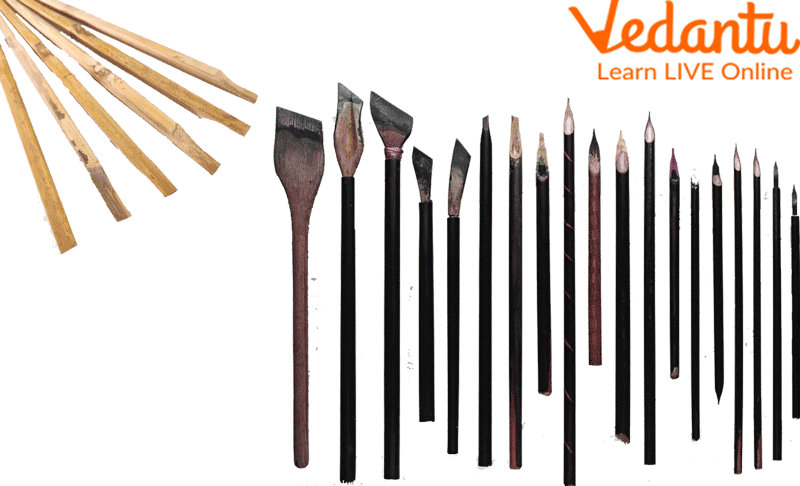




Introduction of Pen
An everyday writing tool known as a pen is used to write or draw on a surface, typically paper. Early pens stored little ink on the nib or in a small cavity or void that needed to be periodically replenished by dipping the pen's tip into an inkwell. These pens are only used in a few specialised fields today, such as calligraphy and drawing. Ballpoint pens, rollerball pens, fountain pens, and pens with felt or ceramic tips have taken the place of writing implements like reed pens, quill pens, and dip pens.
In this article, we will learn who is credited with the invention of the ink pen and the different types of pen and their discovery.

Fountain Pen
Pen
A pen is a writing instrument used to apply ink on a surface, such as paper.
Problems Before Pen
In earlier days, the problem was how to represent our thoughts/ideas in front of others.
How to send our message/letter to others? Without writing, it was not easily possible.
Solution
Ancient Egyptians developed writing on papyrus scrolls when scribes used thin reed brushes or reed pens.
The reed pen might have been used for writing on parchment as long ago as the first dynasty or about 3000 BS.
Reed pens continued to be used until the middle ages.
The reed pen is generally made from bamboo.
The reed pen survived until papyrus was replaced as a writing surface by animal skins, vellum and parchment.

Reed Pen and Reed Brush Pen
Types of Pen
The mechanism of the writing tip and the kind of ink used can be used to classify the most prevalent types of pens today:
Ballpoint Pen
A ballpoint pen works by dispensing an oil-based, viscous ink by rolling a small, hard ball over the surface being written on. One half of the ball is exposed, and the other is submerged in ink from the pen's reservoir; the ball is held captive in a socket at the pen's tip.
Gel Pen
A rolling ball held in the writing tip of a gel pen, similar to a ballpoint pen, is used to dispense ink. Gel pen ink, on the other hand, is made of a water-based gel with a pigment suspended in it, as opposed to oil-based ballpoint pen ink.
Rollerball Pen
A rollerball pen has a ball tip similar to a ballpoint pen and dispenses water-based ink. As a result, gel pens could be viewed as a subclass of rollerball pens; yet, because the word "gel pen" is so well known and used, "rollerball" is more often associated with pens that employ liquid ink.
Fountain Pen
A fountain pen's nib, typically a flat piece of metal with a narrow slit extending inward from the writing tip, delivers water-based liquid ink to the writing surface. Now the question arises, who discovered the fountain pen? In 1884, Lewis Waterman invented a practical fountain pen.
Brush Pen
The writing tip of a brush pen is a little brush filled with ink from a liquid ink reservoir similar to those found in fountain pens and rollerball pens. Both water-based and waterproof ink are options for brush pens, which can also be refilled or used only once.
Uses of Pen
There are many uses of pens of which some are:
The pen is used for writing.
The pen is used as straw or as a children's toy "telescope".
A pen is used to release a bicycle lock.
It is used to transmit and store secret messages (pop out the tube of ink, insert a small paper scroll, and put the ink back)
The pen is used for creating a chandelier.
Interesting Facts About Pen
Pens are the first item that spring to mind when we think of writing on paper. Below are 10 lines for a pen.
A pen is a common writing instrument used for paper.
A pen's components include a tip, an ink container or reservoir, a cap, and a plastic body known as the barrel.
A pen can be used to write with the ink of various colours.
The proverb "pen is mightier than the sword" is significant in this context. It means that ideas expressed in writing can be much more consequential than violence. Words can influence and inspire countless people, and they can live on indefinitely because, in today’s world, words affect people more than power. Books have influenced people for ages, and this era is getting more influenced by words than ever.
Writing requires the use of a pen, which is essential.
There are numerous types of pens on the market, including gel pens, ball pens, ink pens, etc.
Digital pens are also becoming more popular as a result of technological improvement.
Summary
In this article, we have discussed the different pens and much more. The invention of the pen has made our lives better in many senses. Firstly, the earlier method of dipping things in ink and writing was tiring, and it was impossible to carry that ink everywhere.
But now, the invention of the pen has made it easier to write anytime and anywhere. A pen represents many things, including expression, learning, and production. We have discussed some interesting facts about pens and the uses of pens.
FAQs on Discovery of Pen
1. Who invented the ink pen?
Romanian Petrache Poenaru, a student in Paris, created a fountain pen that employed a quill pen as the ink reservoir. In May 1827, the French government granted a patent for it. Then, in the 1850s, the number of fountain pen patents and production rose. John J. Loud received the first ballpoint pen patent on October 30, 1888.
2. When was ink invented?
It is said that evidence suggests that the ink has been in use since 256 BC.
3. Who made the first pen, or who discovered the pen?
Petrache Poenaru is credited for the invention of the pen. He was the one who first came up with the introduction of the pen.









